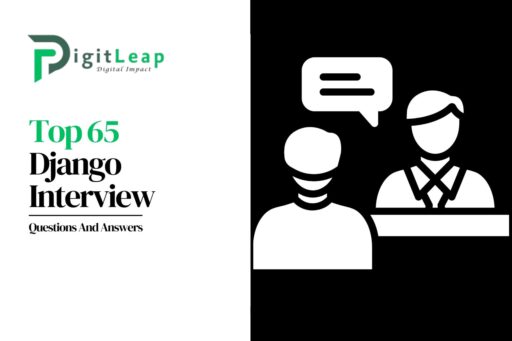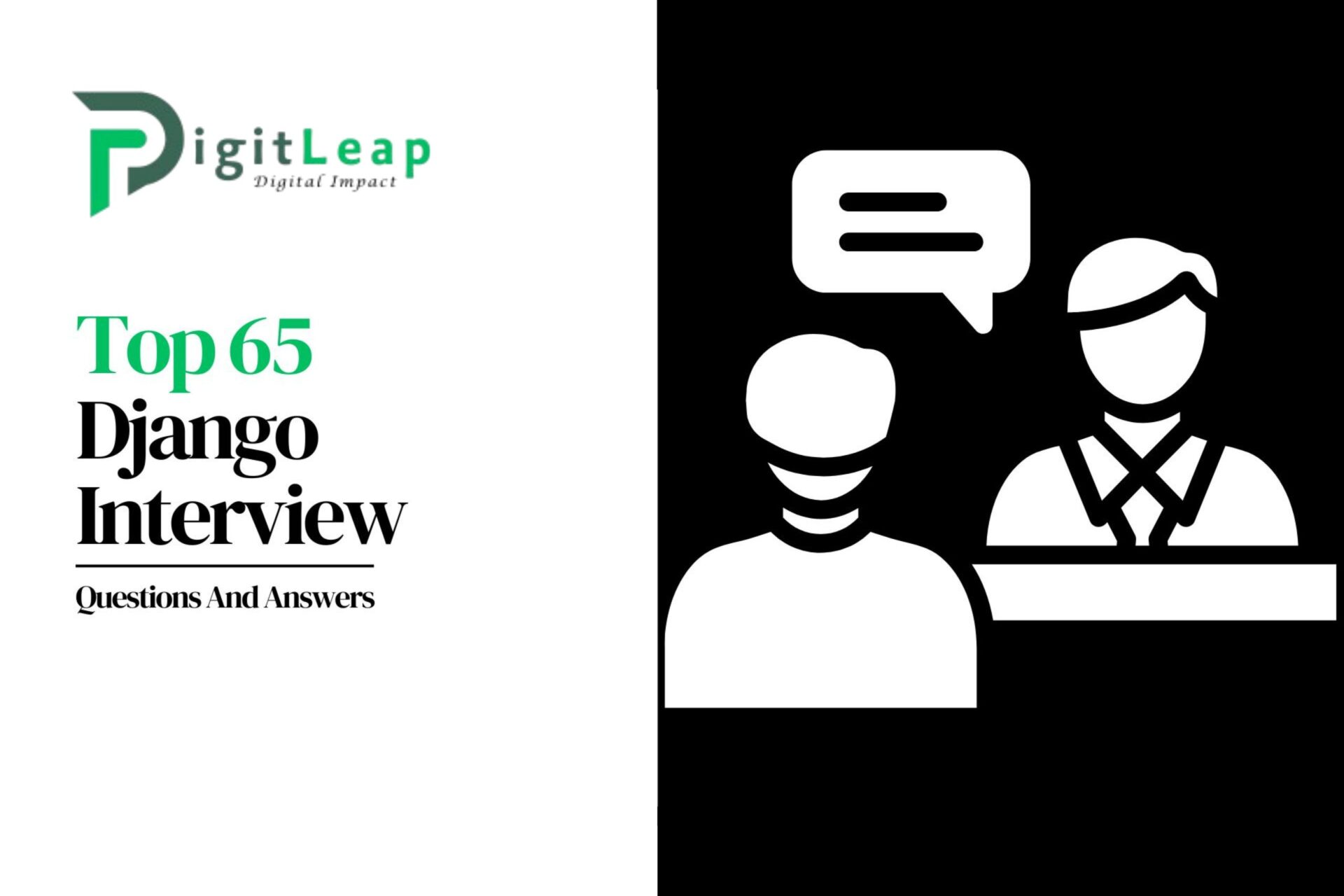Top 65 Django Interview Questions and Answers in 2024
1. What is Django?
Answer:
Django is a high-level Python web framework that simplifies the development of web applications by providing a robust and scalable framework with built-in features like ORM, authentication, and routing. It follows the “batteries-included” philosophy, offering a lot of functionality out of the box.
2. What are the key features of Django?
Answer:
Key features include:
- MTV Architecture: Model-Template-View architecture.
- ORM: Object-Relational Mapping to interact with databases.
- Admin Interface: Automatically generated admin interface.
- Security: Built-in protection against common threats (e.g., CSRF, XSS).
- Scalability: Easily scalable and supports various databases.
3. What is the difference between Django and Flask?
Answer:
- Django: A full-stack framework with built-in features for ORM, authentication, and admin interface.
- Flask: A micro-framework offering more flexibility and minimalism, requiring third-party extensions for additional features.
4. How do you create a new Django project?
Answer:
Use the Django command-line tool:
bashCopy codedjango-admin startproject projectname
5. What is a Django app?
Answer:
A Django app is a self-contained module that handles a specific aspect of the application, such as a blog, user authentication, or a forum. Multiple apps can be included in a single Django project.
6. What is a model in Django?
Answer:
A model in Django represents a database table. It is defined using a Python class and provides a way to interact with database records through Django’s ORM.
7. How do you create a model in Django?
Answer:
Define a model by creating a class in the models.py file of an app:
pythonCopy codefrom django.db import models
class MyModel(models.Model):
field_name = models.CharField(max_length=100)
8. What are Django migrations?
Answer:
Migrations are Django’s way of propagating changes made to models (e.g., adding or removing fields) to the database schema. They are used to maintain the database schema in sync with the models.
9. How do you create and apply migrations in Django?
Answer:
Create migrations with:
bashCopy codepython manage.py makemigrations
Apply migrations with:
bashCopy codepython manage.py migrate
10. What is a view in Django?
Answer:
A view is a function or class-based component that receives a web request and returns a web response. Views are responsible for processing user requests, interacting with models, and rendering templates.
11. What is a URLconf in Django?
Answer:
URLconf (URL Configuration) is a mapping between URL patterns and views. It routes incoming requests to the appropriate view based on the URL.
12. How do you define URL patterns in Django?
Answer:
URL patterns are defined in the urls.py file of an app or the project. They use the path() or re_path() functions to map URLs to views:
pythonCopy codefrom django.urls import path
from . import views
urlpatterns = [
path('example/', views.example_view, name='example'),
]
13. What is Django’s template language?
Answer:
Django’s template language is used to render dynamic HTML pages. It allows embedding logic within HTML files, such as loops and conditionals, to display data.
14. How do you create a template in Django?
Answer:
Create an HTML file in the templates directory of your app and use Django’s template syntax to render dynamic content:
htmlCopy code<!DOCTYPE html>
<html>
<head>
<title>My Page</title>
</head>
<body>
<h1>{{ title }}</h1>
</body>
</html>
15. What is a Django form?
Answer:
A Django form is a way to handle user input and validation. It is used to create, display, and validate forms in web applications.
16. How do you create a form in Django?
Answer:
Define a form by creating a class in forms.py:
pythonCopy codefrom django import forms
class MyForm(forms.Form):
name = forms.CharField(max_length=100)
email = forms.EmailField()
17. What is the purpose of Django’s admin interface?
Answer:
Django’s admin interface provides a web-based interface for managing database records. It allows administrators to add, edit, and delete records without writing any code.
18. How do you customize the Django admin interface?
Answer:
Customize the admin interface by registering models with a custom ModelAdmin class in admin.py:
pythonCopy codefrom django.contrib import admin
from .models import MyModel
class MyModelAdmin(admin.ModelAdmin):
list_display = ('field_name',)
admin.site.register(MyModel, MyModelAdmin)
19. What is a Django middleware?
Answer:
Middleware is a framework of hooks into Django’s request/response processing. It allows processing requests before they reach the view and responses before they are returned to the client.
20. How do you add custom middleware in Django?
Answer:
Define a custom middleware class and add it to the MIDDLEWARE setting in settings.py:
pythonCopy codeclass MyCustomMiddleware:
def __init__(self, get_response):
self.get_response = get_response
def __call__(self, request):
# Code to execute for each request
response = self.get_response(request)
return response
21. What are Django signals?
Answer:
Django signals are a way to allow certain senders to notify a set of receivers when certain actions have taken place, such as saving or deleting a model instance.
22. How do you use Django signals?
Answer:
Define a signal receiver function and connect it to a signal using the @receiver decorator:
pythonCopy codefrom django.db.models.signals import post_save
from django.dispatch import receiver
from .models import MyModel
@receiver(post_save, sender=MyModel)
def my_handler(sender, instance, **kwargs):
# Code to execute after a MyModel instance is saved
23. What is Django REST Framework (DRF)?
Answer:
Django REST Framework (DRF) is a powerful and flexible toolkit for building Web APIs in Django. It provides tools for serializing data, handling HTTP methods, and authentication.
24. How do you create a simple API using DRF?
Answer:
Define a serializer, viewset, and URL routing:
pythonCopy code# serializers.py
from rest_framework import serializers
from .models import MyModel
class MyModelSerializer(serializers.ModelSerializer):
class Meta:
model = MyModel
fields = '__all__'
# views.py
from rest_framework import viewsets
from .models import MyModel
from .serializers import MyModelSerializer
class MyModelViewSet(viewsets.ModelViewSet):
queryset = MyModel.objects.all()
serializer_class = MyModelSerializer
# urls.py
from rest_framework.routers import DefaultRouter
from .views import MyModelViewSet
router = DefaultRouter()
router.register(r'mymodel', MyModelViewSet)
urlpatterns = router.urls
25. What is Django’s ORM?
Answer:
Django’s ORM (Object-Relational Mapping) is a system that allows developers to interact with the database using Python objects rather than SQL queries. It translates Python code into SQL queries.
26. How do you perform database queries using Django’s ORM?
Answer:
Use Django’s query methods such as filter(), get(), and exclude():
pythonCopy code# Fetch all objects
MyModel.objects.all()
# Filter objects
MyModel.objects.filter(name='John')
# Get a single object
MyModel.objects.get(id=1)
27. What is a Django context processor?
Answer:
A context processor is a function that adds variables to the context of every template rendered, allowing you to make data available to all templates.
28. How do you create a custom template tag in Django?
Answer:
Define a custom template tag in a templatetags directory within your app:
pythonCopy code# templatetags/my_tags.py
from django import template
register = template.Library()
@register.simple_tag
def my_custom_tag(arg1):
return f"Hello, {arg1}"
29. What is Django’s get_object_or_404?
Answer:get_object_or_404 is a shortcut function that retrieves an object from the database or raises a Http404 exception if the object does not exist.
30. How do you handle static files in Django?
Answer:
Static files are managed by placing them in a static directory and configuring the STATIC_URL and STATICFILES_DIRS settings in settings.py.
31. What is Django’s render function used for?
Answer:
The render function is a shortcut for rendering a template with a given context, combining the template and context into an HTTP response.
32. How do you handle file uploads in Django?
Answer:
Handle file uploads by creating a model with a FileField or ImageField and processing the uploaded files in a view:
pythonCopy code# models.py
class MyModel(models.Model):
file = models.FileField(upload_to='uploads/')
# views.py
def upload_file(request):
if request.method == 'POST':
form = MyForm(request.POST, request.FILES)
if form.is_valid():
form.save()
33. What is Django’s manage.py?
Answer:manage.py is a command-line utility that allows you to interact with your Django project. It provides commands for development tasks like running the server, applying migrations, and creating app components.
34. How do you secure Django applications?
Answer:
Secure Django applications by:
- Using Django’s built-in security features (e.g., CSRF protection).
- Configuring HTTPS.
- Validating user inputs and using parameterized queries.
- Keeping Django and dependencies up to date.
35. What is the purpose of settings.py in a Django project?
Answer:settings.py contains configuration for the Django project, including database settings, static file configurations, middleware, and installed apps.
36. What is a QuerySet in Django?
Answer:
A QuerySet is a collection of database queries that Django ORM generates. It allows you to filter, order, and manipulate data.
37. How do you implement user authentication in Django?
Answer:
Use Django’s built-in authentication system by including django.contrib.auth in INSTALLED_APPS and using views and forms from django.contrib.auth for login and registration.
38. What is the admin.site.register function used for?
Answer:admin.site.register is used to register a model with the Django admin site, making it available in the admin interface.
39. How do you handle database relationships in Django models?
Answer:
Define relationships using fields like ForeignKey, OneToOneField, and ManyToManyField:
pythonCopy codeclass Author(models.Model):
name = models.CharField(max_length=100)
class Book(models.Model):
title = models.CharField(max_length=100)
author = models.ForeignKey(Author, on_delete=models.CASCADE)
40. What are Django’s class-based views (CBVs)?
Answer:
Class-based views provide an object-oriented approach to views, allowing you to reuse and extend views by inheriting from Django’s built-in view classes.
41. How do you create a class-based view in Django?
Answer:
Create a class-based view by inheriting from django.views.View or other built-in CBV classes:
pythonCopy codefrom django.views import View
from django.http import HttpResponse
class MyView(View):
def get(self, request):
return HttpResponse("Hello, world!")
42. What is Django’s GenericView?
Answer:GenericView is a base view class that provides common patterns for handling web requests, such as displaying a list of objects or a detail view of a single object.
43. How do you set up a Django project for production?
Answer:
For production, configure settings for security (e.g., DEBUG set to False), use a production-ready web server (e.g., Gunicorn), and configure static file serving and database settings.
44. What is Django’s cache framework?
Answer:
Django’s cache framework provides a way to cache data and query results to improve performance. It supports various backends, including memory and file-based caching.
45. How do you implement caching in Django?
Answer:
Use Django’s cache framework to cache views or data:
pythonCopy codefrom django.core.cache import cache
# Cache a value
cache.set('my_key', 'my_value', timeout=60)
# Retrieve a cached value
value = cache.get('my_key')
46. What is a Django signal?
Answer:
A Django signal allows certain senders to notify a set of receivers when certain actions occur. Signals can be used for handling events like saving or deleting models.
47. How do you implement custom signal handlers?
Answer:
Define signal handlers and connect them to signals:
pythonCopy codefrom django.db.models.signals import post_save
from django.dispatch import receiver
@receiver(post_save, sender=MyModel)
def my_handler(sender, instance, **kwargs):
# Handle signal
48. What are Django’s forms and model forms?
Answer:
- Forms: General forms for collecting user input.
- ModelForms: Forms specifically tied to Django models, automatically generating form fields based on the model.
49. How do you use Django’s ContextMixin?
Answer:ContextMixin is used in class-based views to provide additional context data to the template:
pythonCopy codefrom django.views.generic.base import ContextMixin
class MyView(ContextMixin, View):
def get_context_data(self, **kwargs):
context = super().get_context_data(**kwargs)
context['my_data'] = 'some value'
return context
50. What are Django’s Session and Cookie frameworks?
Answer:
- Session Framework: Manages user sessions and stores session data on the server.
- Cookie Framework: Manages cookies sent between the server and client, allowing you to store data on the client side.
51. What are Django’s transaction management features?
Answer:
Django’s transaction management allows you to handle database transactions, ensuring that operations are atomic, consistent, isolated, and durable (ACID).
52. How do you use Django’s transaction.atomic?
Answer:transaction.atomic ensures that all operations within the block are treated as a single transaction:
pythonCopy codefrom django.db import transaction
with transaction.atomic():
# Database operations
53. What is Django’s AdminSite class?
Answer:AdminSite is the class responsible for managing the Django admin interface. You can customize the admin interface by creating a custom AdminSite.
54. How do you create a custom AdminSite in Django?
Answer:
Subclass AdminSite and override methods to customize the admin interface:
pythonCopy codefrom django.contrib.admin import AdminSite
class MyAdminSite(AdminSite):
site_header = 'My Admin Interface'
admin_site = MyAdminSite(name='myadmin')
55. What is a Django ContextProcessor?
Answer:
A ContextProcessor is a function that adds data to the context of every template. It is used to make global data available in all templates.
56. How do you implement Django’s RedirectView?
Answer:RedirectView provides a way to redirect one URL to another. It is useful for simple URL redirection:
pythonCopy codefrom django.views.generic.base import RedirectView
class MyRedirectView(RedirectView):
url = '/new-url/'
57. What is Django’s QuerySet API?
Answer:
The QuerySet API allows for filtering, ordering, and manipulating data in Django models. It provides methods for querying the database efficiently.
58. How do you use Django’s get_list_or_404 and get_object_or_404?
Answer:
get_object_or_404: Retrieves a single object or raises aHttp404exception if not found.get_list_or_404: Retrieves a list of objects or raises aHttp404exception if the list is empty.
59. What are Django’s settings.py and manage.py files used for?
Answer:
settings.py: Contains configuration settings for the Django project.manage.py: A command-line utility for administrative tasks in the project.
60. How do you use Django’s signals to handle post-save actions?
Answer:
Connect a signal receiver to handle actions after saving a model instance:
pythonCopy codefrom django.db.models.signals import post_save
from django.dispatch import receiver
@receiver(post_save, sender=MyModel)
def post_save_handler(sender, instance, **kwargs):
# Handle post-save action
61. How do you implement Django’s GenericCBV?
Answer:GenericCBV (Generic Class-Based Views) provides common views like list and detail views. Use generic view classes to simplify view implementation:
pythonCopy codefrom django.views.generic import ListView, DetailView
from .models import MyModel
class MyModelListView(ListView):
model = MyModel
class MyModelDetailView(DetailView):
model = MyModel
62. What is Django’s QuerySet caching?
Answer:
Django’s QuerySet caching refers to the internal caching of query results to optimize performance and reduce redundant database queries.
63. How do you handle database migrations in Django?
Answer:
Use Django’s migration system to manage changes to the database schema:
bashCopy codepython manage.py makemigrations
python manage.py migrate
64. What is Django’s templating language?
Answer:
Django’s templating language is used to dynamically generate HTML pages. It provides syntax for template inheritance, including variables, filters, and template tags.
65. How do you use Django’s FileSystemStorage for handling files?
Answer:FileSystemStorage handles file storage on the server’s filesystem. You can use it to manage file uploads:
pythonCopy codefrom django.core.files.storage import FileSystemStorage
fs = FileSystemStorage()
filename = fs.save('myfile.txt', file)
uploaded_file_url = fs.url(filename)
These questions and answers cover a broad range of Django topics and should help in preparing for an interview or improving your understanding of Django.
Other Important Q&A List :
- OOPs Interview Questions And Answers
- SQL Interview Questions and Answers
- Content Writing Interview Questions and Answers
- Email Marketing Interview Questions and Answers
- Django Interview Questions and Answers
- C Programming Interview Questions and Answers
- ReactJS Interview Questions and Answers
- Angular Interview Questions and Answers
- Power BI Interview Questions and Answers
- Top DBMS Interview Questions and Answers
- Python Interview Questions and Answers
- MySQL Interview Questions and Answers
- Java Interview Questions and Answers
- Data Structures Interview Questions
- Flutter Interview Questions and Answers
- JavaScript Interview Questions and Answers
- PHP Interview Questions and Answers
- CSS Interview Questions and Answers
- HTML Interview Questions and Answers






